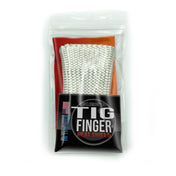TIG Welding Cold Rolled Steel vs 4130 or Hot Rolled Steel
Have you ever noticed that when you are tig welding cold rolled steel that sometimes the puddle wanders?
I have found that tig welding 4130 chromoly or even hot rolled steel is easier than tig welding cold rolled steel.
4130 chromoly and Hot Rolled Steel don't rely nearly as much on the rolling or cold working effect for strength.
I think that is why both hot rolled steel and 4130 seem to weld better that cold rolled steel.
I have never heard anyone explain why but here is my theory on what happens when you tig weld cold rolled steel.
Learn more about our Awesome Arsenal Kits for both 9/20 and 17 style torches
Unless it is fully annealed, Cold rolled steel has built up stress from the cold rolling process. That is why cold rolled steel is so much stiffer than hot rolled steel.
The grains of cold rolled steel are elongated from the rolling process.
When the cold rolled steel base metal under the bead and next to the bead reaches a certain temperature while welding, ( they call this the recrystallization temperature) the grains transform back into blocky grains instead of elongated grains.
You can notice the difference in ripples in the 2 photos below.
The first pic is cold rolled steel and every few ripples there is a bobble.

Whereas the 4130 tig bead ripples seem more consistent

I think that is why you can be welding along for several ripples and then all of a sudden, the puddle wanders a bit. Not a big deal but it is annoying when you are trying to make a nice bead with uniform ripple pattern.
I like to order cold rolled test plates for my videos because there is less metal prep involved.
Occasionally, I purchase hot rolled test pieces if the cold rolled is out of stock so that is how I noticed this phenomenon ,
I was welding beads on both cold rolled steel and hot rolled steel one day and I noticed that the hot rolled beads were going better once I reached a certain amperage.
But that same amperage on cold rolled would cause the puddle to wander.
Aft first, I thought I was starting penetrate and pull oxidation into the puddle because I have experienced that effect before on square tubing welds.
But there was no evidence of full penetration.
I also noticed that if I backed off on the amperage, the puddle on the cold rolled was more stable. The problem with that is that there seems to be a fine line between a super stable weld puddle as opposed to a puddle that wanders a bit but using adequate amperage to get good fusion and get the work done.
I really noticed this on a project I welded up a few years ago on a piece sent to me from precision tube laser company.
The project was called the round steel hurricane project
It was a fun project but I had a hard time making really uniform beads and I am pretty sure it was because of the tubing being cold rolled and partially annealing while I was welding.
I think I will weld another one soon and test out ER70S-2 vs ER70S6 filler wires too. That should be fun








